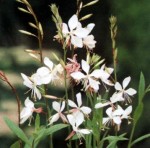 Native to Louisiana, Oklahoma, and Texas, this herbaceous perennial is a member of willowherb family, the Onagraceae, that also includes evening primrose, fushia, and clarkia. Plants have a taproot and grow up to 5′ tall with wiry wand-like stems and narrow, lanceolate leaves that are sessile, 1-3″ long, and occasionally have maroon spots. In summer, long terminal panicles of pink buds appear that open to delicate, moth-like tubular white flowers that fade to rose. The flowers have prominent stamens, are .5-1″ wide, and fall cleanly as they fade. The plants are particularly appealing when a breeze blows and the flowers flutter on the see through stems. White gaura is a tough plant that can thrive in the heat and humidity of the South as well as the searing heat of the Southwest. It is a good choice for a xeriscape, border, native plant garden, wildflower garden, or meadow garden. The genus name, Gaura, comes from the Greek word gauros meaning superb and refers to the flowers. The specific epithet hones Texas plant collector Ferdinand Jacob Lindheimer (1801-1879).
Native to Louisiana, Oklahoma, and Texas, this herbaceous perennial is a member of willowherb family, the Onagraceae, that also includes evening primrose, fushia, and clarkia. Plants have a taproot and grow up to 5′ tall with wiry wand-like stems and narrow, lanceolate leaves that are sessile, 1-3″ long, and occasionally have maroon spots. In summer, long terminal panicles of pink buds appear that open to delicate, moth-like tubular white flowers that fade to rose. The flowers have prominent stamens, are .5-1″ wide, and fall cleanly as they fade. The plants are particularly appealing when a breeze blows and the flowers flutter on the see through stems. White gaura is a tough plant that can thrive in the heat and humidity of the South as well as the searing heat of the Southwest. It is a good choice for a xeriscape, border, native plant garden, wildflower garden, or meadow garden. The genus name, Gaura, comes from the Greek word gauros meaning superb and refers to the flowers. The specific epithet hones Texas plant collector Ferdinand Jacob Lindheimer (1801-1879).
Type: Herbaceous perennial.
Bloom: White moth-like flowers with a touch of pink bloom on long reddish stems all summer if deadheaded.
Size: 36-48” H x 24-36” W.
Light: Full sun but tolerates partial shade.
Soil: Average to lean, loose, medium moist, well-drained soil.
Hardiness: Zones 5-10.
Care: Deadhead to prolong bloom season and control self seeding.
Pests and Diseases: Root rot in poorly drained soil; susceptible to rust, powdery mildew, aphids, white fly, and flea beetles.
Propagation: Taproot makes division difficult; best propagated from seed; self sows.
Companion plants: Pink or white garden phlox (Phlox paniculata), coneflower (Echinacea spp.), true lilies (Lilium sp), daylilies (Hemerocallis sp.), and blue salvias.
